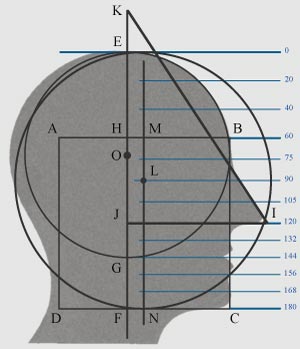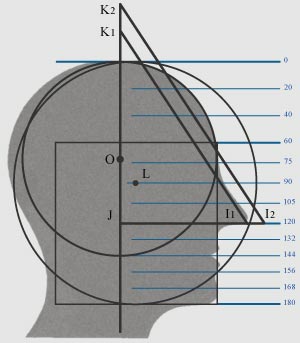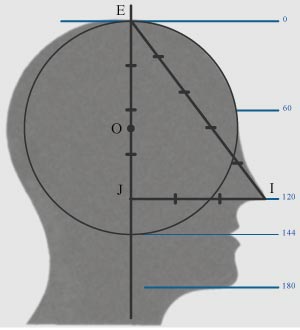-
Alongside with circle and square in shapes of a human face in profile it is possible to see a triangle, and accordingly facial proportions in a context of physiognomy it is possible to consider as proportional ratios of the circle and square which symbolize consciousness and feelings, with the geometrical figure of triangle which symbolizes human individuality, that is shown on the chart.
 |
The triangle of individuality JKI has rectangular
angle in the point J, namely the side JI is perpendicular to
the line BC and parallel to the line AB of the square, and also JI
corresponds with the line of a nose which is border between physiognomic
spheres of individuality and feelings. The side JK of triangle coincides with diameter and centre of the circle in the point O, and also JK is parallel to the line BC and perpendicular to the line AB of the square. The side KI of triangle is a tangent to a nose-tip and to the least expressed point of top of a nose bridge, namely to construct the triangle of individuality in view of physiognomy of a human face in profile it is necessary to draw the line which adjoins the most expressed point of a nose-tip and adjoins the least expressed point at top of a nose bridge, and it is necessary to find point K in crossing with the line which is continuation of vertical diameter of the circle, and point I in crossing with the line of a nose. |
The triangle covers physiognomic spheres of consciousness and individuality
but in view of physiognomy of half faces symbolizes human individuality. In some cases the triangle exceeds sphere of
consciousness and covers space outside vertical scale of measurements which are
limited to lines of top of a head and a chin, that allows to speak about different types
of individuality.
If the point K exceeds top of a head then individuality aspires to transcendental,
namely the man or woman estimates itself in the world from the point of view of
transcendental philosophy. If the point K is lower than top of a head then
individuality aspires to concrete, namely the man or woman estimates itself in the world
from the point of view of materialistic philosophy. If the point K coincides with
the line of top of a head then individuality of the man or woman is balanced,
namely there is no obvious aspiration to transcendental or concrete.
Besides position of the point I in a context of physiognomy of a human face allows to speak about different types of
individuality, that is shown on the following chart:
 |
Position of the point I is necessary for determining
concerning the circle with the centre in the point L which is on distance
of 90 zens from top of a head and coincides with the vertical line which
divides the square of feelings half-and-half. Namely it is necessary to
divide the side AB half-and-half that distances AM and MB would be
equal, and to draw the line perpendicular to the side AB
across the point M. Then it is necessary on this line to note the point L which is removed
from top of a head on distance of 90 zens, and to draw the circle which
is a tangent to lines of top of a head and a chin with the central point L. This circle in a context of physiognomy it is possible to name as "circle of psycho-physiological essence", as the circle has diameter of 180 zens and covers all three physiognomic spheres of a face, that actually displays the human essence. Crossing of the circle of psycho-physiological essence with the line of a nose is the border agrees which the point I can be within or outside the circle of essence. |
If the point I is within the circle of essence then individuality does not overcome psycho-physiological borders, namely the man
or woman does not estimate own individuality as surpassing psycho-physiological
reality. If the point I is outside the circle of essence then individuality aspires with existential outlook, namely the man
or woman estimates itself in the world from the point of view of existential philosophy
according to which individuality overcomes borders of psycho-physiological reality. If
the point I coincides with the circle of psycho-physiological essence then there is
a balance of essence and individuality.
The information about displays of concepts
of existential philosophy in features of a human face look on pages of
this website in section: half faces (concepts 2).
Besides the angle in the point I allows to speak about types of individuality in
view of physiognomy. Namely geometrical figure JKI is a rectangular triangle in
which the right angle (90 degrees) is in point J, and corners in points I and K
have varied sizes, that determines different individual types which are not
connected with position of point K above or below top of a head, and do not
depend on position of the point I within or outside the circle of
psycho-physiological essence. And accordingly the size of the angle in point I
determines other parameters of individuality rather than positions of points K
and I, that is shown on the chart.
 |
As it is possible to see on the chart, if the point I1
coincides with the circle of psycho-physiological essence, and if the point I2
is outside the circle then in any case angles in points I1
or I2
have identical sizes, if positions of points K1 and K2
change proportionally to positions of points I1
and I2. Hence, the angular size in point I
specifies parameters of individuality which are others, rather than
parameters of individuality caused by position of points K and I. About different parameters of human individuality and principles of physiognomic analyses of geometrical lines and angles in the triangle of individuality in a context of physiognomy I shall try to tell in the future, as it is a complicated question, but the essence of this question can be clear from the point of view of esoteric values which are in the sacred Egyptian triangle. |
-
The sacred Egyptian or Pythagorean is the rectangular triangle with the attitude
of sides 3:4:5 because such triangle was a basis of geometrical constructions in
ancient Egypt, and also is the key geometrical figure in the theorem of Pythagoras.
Egyptians applied proportions of the sacred triangle at calculations of
architectural proportions of pyramids and temples. But also the sacred Egyptian
triangle it is possible to consider as esoteric symbol of tripartite structure
of the human personality. Namely the vertical cathetus symbolizes a vertical of
consciousness, the horizontal cathetus symbolizes feelings, and the hypotenuse
symbolizes individuality or an individual soul which arises from interaction of
consciousness and feelings, and which forms the triune human personality, that
is shown on the following chart.
 |
The geometrical figure JEI is the incorporated triangle
of individuality and consciousness and feelings or otherwise to tell the triangle of the triune
human personality. To draw triangle JEI it is necessary to consider following data: - the cathetus JE corresponds with vertical diameter in the circle of consciousness with the centre in point O; - the cathetus JI corresponds with the line of a nose; - the point I corresponds with a nose-tip; - the point E is crossing of vertical diameter of the circle of consciousness with the line of top of a head. The information on lines of a nose and top of a head, and rule for construction of the circle of consciousness in a context of physiognomy of a human face look on the previous pages of this section of website. If triangle JEI has the ratio of sides 3:4:5, namely horizontal cathetus JI makes three parts, and vertical cathetus JE makes four parts, and hypotenuse EI makes five parts then triangle JEI corresponds to parameters of the sacred Egyptian triangle. For example, if cathetus JI has the size of 90 zens (30x3=90), and cathetus JE has the size of 120 zens (30x4=120), and the hypotenuse EI has the size of 150 zens (30x5=150). |
If in profile of a human face the triangle JEI has parameters of the sacred Egyptian
triangle then it testifies to proportional harmony or balance of individuality with
consciousness and feelings in a context of physiognomy. But if in facial profile
the triangle JEI has no parameters of the sacred Egyptian triangle then the
consciousness prevails in structure of a human
personality if the vertical cathetus has the greater size, or
feelings prevail if the horizontal cathetus has the greater size. Accordingly
individuality of the man or woman is subject to the greater influence of consciousness or feelings.
It is possible to measure the angle of geometrical figure JEI in point I, and if
this angle has size approximately 53 degrees then geometrical figure possesses
parameters of the sacred Egyptian triangle. Namely during physiognomic analyses
it is possible to not measure sizes of cathetuses and
hypotenuse, but if the angle in point I has size 53 degrees then
the man or woman has a balanced personality. If the angular size in point I is less
than 53 degrees then the horizontal cathetus prevails, and accordingly
individuality of the man or woman is subject to the greater influence of feelings. And if
the angular size in point I is more than 53 degrees then the vertical cathetus prevails, and accordingly individuality of the man
or woman is subject to the greater influence of consciousness.
It is necessary to mean that triangle JEI is other parameter, rather than
triangle JKI about which it is told above on this page, and consequently it is
necessary to distinguish psychological characteristics which can be made by
means of physiognomic analyses of two triangles. Namely triangle JEI allows to
speak about the combined balance of individuality with consciousness and
feelings, and triangle JKI allows to correlate individuality to borders of a
human psycho-physiological essence.
Except for the listed physiognomic sizes it is possible to consider many other
geometrical figures and lines in features of a human face.
And also it is possible to calculate proportional ratios of physiognomic sizes
and to consider numerical parameters as numerological numbers. For example, it
is possible to calculate proportional ratios of distances EJ/EF and IJ/EF, then
it is possible to consider numerical values as numbers in numerology, and to do
conclusions about psychological characteristics of a man or woman by means of
values in numerology.
The necessary information about numerological calculations of proportional
ratios in a context of physiognomy look on the previous page in this section of
website.
It is necessary to consider that ratio EJ/EF is calculated within the limits of
physiognomic scale of measurements on vertical, and ratio IJ/EF is calculated on
horizontal, but units of measurements in both cases should be zens, that is
possible if for the physiognomic analysis you use a photo which is placed in the
graphic software program of computer, and the human half face in the computer
program is correlated with a grid in which divisions are proportional to zens.
The following page results more detailed information on links of the sacred Egyptian and Pythagorean triangle with proportions of a human face in physiognomy.
-